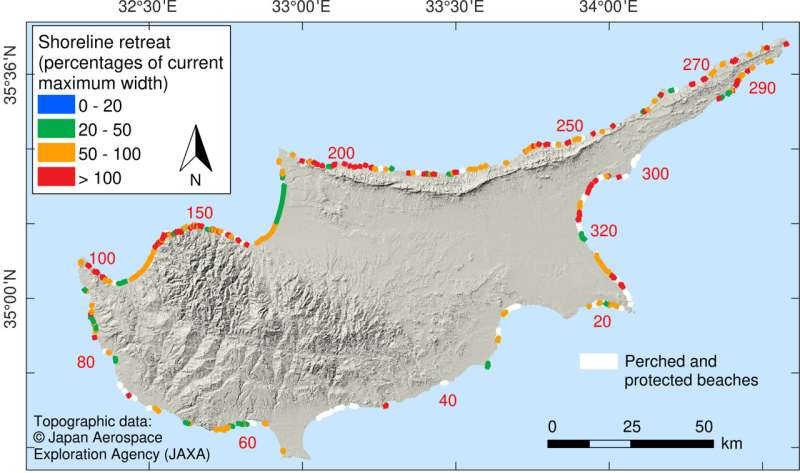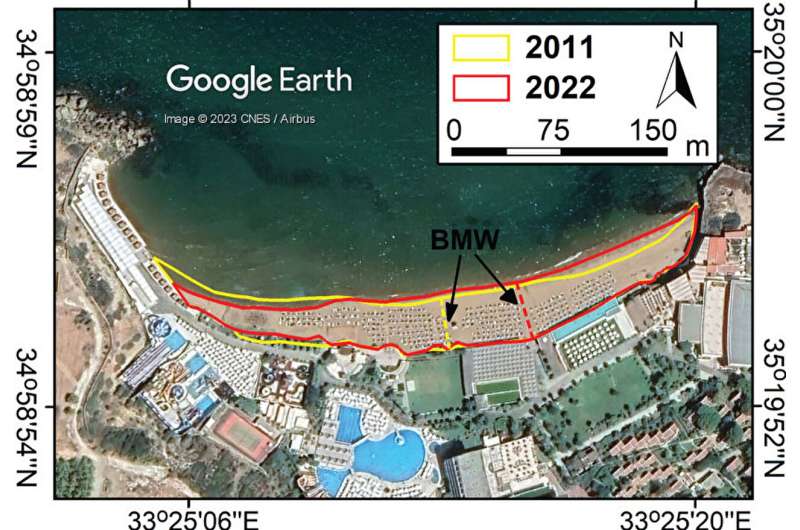Cyprus’ beaches could disappear by 2100 due to climate change
Cyprus’ beaches are at risk due to climate change as increased sea levels and wave action erode the sandy shores. This has prompted a dire warning from researchers at the University of the Aegean, Greece, that up to 72% of the island’s beaches could disappear by 2100. Cyprus is the third largest island in the Mediterranean, with a coastline spanning 740 km.
Their research, published in Frontiers in Marine Science, used satellite imagery to measure the dimensions of the 241 unprotected beaches, while models were created to predict sea level rise and erosive wave action from storms under various climate scenarios to project the rate of beach retreat over the coming decades. These two issues are further exacerbated by the loss of sediment flowing downstream in rivers to the coast as dams built upstream trap sediment, which means less sand is available to build beaches back up after erosive events.
Extreme sea level rise is projected to increase 60% by 2100 (up to 1.29 m above mean sea level) compared to the baseline level in 2000, with the greatest resulting erosive action occurring on the southern and western coastlines. However, it is the narrow beaches of less the 50 m width that are potentially most susceptible to erosion, with up to 72% modeled to permanently reduce their width by at least half at the end of the century.
Under different IPCC (Intergovernmental Panel on Climate Change) carbon dioxide emission scenarios, as emissions increase, so does sea level. From a scenario where carbon dioxide emissions are at 650 ppm (RCP4.5) increasing to 1,500 ppm (RCP8.5) for worse-case scenario, the researchers found a threefold increase in extreme sea level rise to 2.04 m.

In addition to the effects of sea level rise, the severity and frequency of coastal storms is expected to increase. A modeled 100-year extreme storm event at 2100 is anticipated to overwhelm almost half of the beaches, especially on the northern coastlines, and may cause significant damage to natural ecosystems and anthropogenic infrastructure if sufficient safety measures are not put in place.
Such extreme events under RCP4.5 conditions are predicted to occur every 9 to 27 years from 2050, but under the more severe RCP8.5 conditions, storm frequency would increase to every 2.5 to 13 years, and beyond 2100 could occur multiple times a year.
Given all of this erosive action, total beach retreat was projected for 2% of the beaches by 2050, while up to 16% would retreat by half under RCP8.5 scenario. This increases further still half a century on, as under the same conditions 30% of the beaches are projected to completely retreat and 72% retreat by half by 2100. Consequently, 39 m of coastline could be lost, particularly to the north and east.
The researchers suggest this retreat is problematic as oftentimes tourist infrastructure is built along the coastlines and could be permanently eroded if beach replenishment schemes are not put into action to bring in sand from other areas. This is often taken from marine locations so the sustainability of this strategy and damage it may cause elsewhere is a key consideration.
In addition to such measures, in 2008 buffer zones were implemented to prevent further building of infrastructure directly along coastlines, to reduce economic consequences of damage to tourist centers especially. The researchers further suggest that hard engineering measures may need to be considered, such as seawalls, groins and offshore breakwaters to dampen storm wave erosion and help protect against rising sea levels.
It is not just the toll to human environments that is damaging, but the loss of key habitats for a plethora of shoreline organisms that is important, such as nesting sites for birds. So only we can take action to help our coastlines survive the toll of climate change.
More information:
Isavela N. Monioudi et al, Climate change—induced hazards on touristic island beaches: Cyprus, Eastern Mediterranean, Frontiers in Marine Science (2023). DOI: 10.3389/fmars.2023.1188896
© 2023 Science X Network
Citation:
Cyprus’ beaches could disappear by 2100 due to climate change (2023, July 26)
retrieved 26 July 2023
from https://phys.org/news/2023-07-cyprus-beaches-due-climate.html
This document is subject to copyright. Apart from any fair dealing for the purpose of private study or research, no
part may be reproduced without the written permission. The content is provided for information purposes only.

Cyprus’ beaches are at risk due to climate change as increased sea levels and wave action erode the sandy shores. This has prompted a dire warning from researchers at the University of the Aegean, Greece, that up to 72% of the island’s beaches could disappear by 2100. Cyprus is the third largest island in the Mediterranean, with a coastline spanning 740 km.
Their research, published in Frontiers in Marine Science, used satellite imagery to measure the dimensions of the 241 unprotected beaches, while models were created to predict sea level rise and erosive wave action from storms under various climate scenarios to project the rate of beach retreat over the coming decades. These two issues are further exacerbated by the loss of sediment flowing downstream in rivers to the coast as dams built upstream trap sediment, which means less sand is available to build beaches back up after erosive events.
Extreme sea level rise is projected to increase 60% by 2100 (up to 1.29 m above mean sea level) compared to the baseline level in 2000, with the greatest resulting erosive action occurring on the southern and western coastlines. However, it is the narrow beaches of less the 50 m width that are potentially most susceptible to erosion, with up to 72% modeled to permanently reduce their width by at least half at the end of the century.
Under different IPCC (Intergovernmental Panel on Climate Change) carbon dioxide emission scenarios, as emissions increase, so does sea level. From a scenario where carbon dioxide emissions are at 650 ppm (RCP4.5) increasing to 1,500 ppm (RCP8.5) for worse-case scenario, the researchers found a threefold increase in extreme sea level rise to 2.04 m.

In addition to the effects of sea level rise, the severity and frequency of coastal storms is expected to increase. A modeled 100-year extreme storm event at 2100 is anticipated to overwhelm almost half of the beaches, especially on the northern coastlines, and may cause significant damage to natural ecosystems and anthropogenic infrastructure if sufficient safety measures are not put in place.
Such extreme events under RCP4.5 conditions are predicted to occur every 9 to 27 years from 2050, but under the more severe RCP8.5 conditions, storm frequency would increase to every 2.5 to 13 years, and beyond 2100 could occur multiple times a year.
Given all of this erosive action, total beach retreat was projected for 2% of the beaches by 2050, while up to 16% would retreat by half under RCP8.5 scenario. This increases further still half a century on, as under the same conditions 30% of the beaches are projected to completely retreat and 72% retreat by half by 2100. Consequently, 39 m of coastline could be lost, particularly to the north and east.
The researchers suggest this retreat is problematic as oftentimes tourist infrastructure is built along the coastlines and could be permanently eroded if beach replenishment schemes are not put into action to bring in sand from other areas. This is often taken from marine locations so the sustainability of this strategy and damage it may cause elsewhere is a key consideration.
In addition to such measures, in 2008 buffer zones were implemented to prevent further building of infrastructure directly along coastlines, to reduce economic consequences of damage to tourist centers especially. The researchers further suggest that hard engineering measures may need to be considered, such as seawalls, groins and offshore breakwaters to dampen storm wave erosion and help protect against rising sea levels.
It is not just the toll to human environments that is damaging, but the loss of key habitats for a plethora of shoreline organisms that is important, such as nesting sites for birds. So only we can take action to help our coastlines survive the toll of climate change.
More information:
Isavela N. Monioudi et al, Climate change—induced hazards on touristic island beaches: Cyprus, Eastern Mediterranean, Frontiers in Marine Science (2023). DOI: 10.3389/fmars.2023.1188896
© 2023 Science X Network
Citation:
Cyprus’ beaches could disappear by 2100 due to climate change (2023, July 26)
retrieved 26 July 2023
from https://phys.org/news/2023-07-cyprus-beaches-due-climate.html
This document is subject to copyright. Apart from any fair dealing for the purpose of private study or research, no
part may be reproduced without the written permission. The content is provided for information purposes only.
